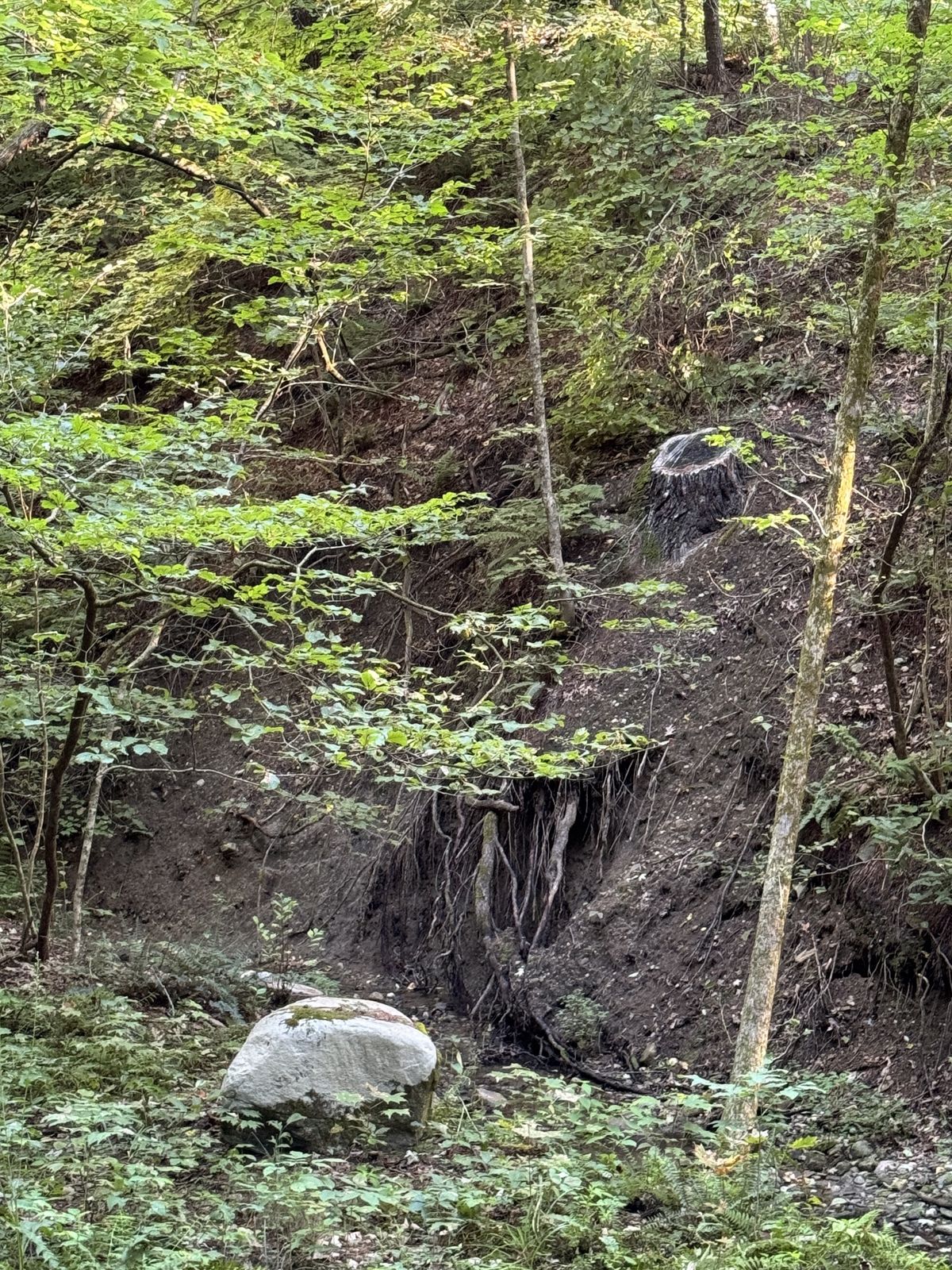The dirt on soil — it is a precious thing

A slope that is eroding. Roots of a white pine, removed as a result of the erosion, shown dangling below.
Dee Salomon

A slope that is eroding. Roots of a white pine, removed as a result of the erosion, shown dangling below.
As of this writing, I have seen far fewer Asian jumping worms on our property than over the past four years. My hands are in the soil every day so I would know. The leaf litter still looks mostly intact and the telltale coffee grounds signature are largely absent. I know it is still too early to be optimistic but I find it odd. I have written before about the infestation and about the damage the worms have done to the property over the past few years (https://www.theungardener.com/articles/dont-look-down). But where have they gone? One might think it correlates to the excessive rain but Peter Groffman from the Cary Institute explained that it is an entirely ‘normal’ process of integration. When the worms colonize an area their populations explode and then they settle in and populations reduce and spread– the food they have devoured is no longer there, also predators become familiar with them as a new food source. This is what is happening here.
One continuing effect of worm invasion is erosion. Over the past several years the worms have loosened the soil. This, compounded by the rain has caused extensive soil erosion, most notably on the sides of a ravine where the soil washed into a stream and then into the Housatonic, taking with it several trees. We felled a massive white pine that was about to topple and take with it a huge chunk of soil that would have then washed away. Dr. Jane Lucas, a soil and microbial ecologist from the Cary Institute is concerned about situations like this. “We are losing soil at a concerning clip- whether by heavy rain that causes topsoil to erode, by compaction from driving on dirt roads, and by leaving bare to dry out. Soil, created over many years, is a precious thing. It is alive, with a microbiome that, like our gut microbiome, contains many of the bacteria, fungus, and other organisms (like invertebrates and viruses) that are the basis for the health of trees and other plants.”
Remembering that soil is alive will guide your actions to keep your soil from degrading. Dried out soil is unhealthy; so is water-logged soil. Soil should stay covered and better to keep soil covered with plants rather than mulch, but mulch is better than leaving it bare. Think twice (or thrice!) about using pesticides or herbicides as these have the unwanted effect of destroying the microbes and other living elements needed for healthy soil. Rather than fertilizing your plants, you want to feed your soil, specifically feeding the microbiome, to keep it healthy and your plants healthy. Compost should not be used in place of soil but can be a useful amendment to soil as organic matter in the form of decaying plant material can help soil retain water and nutrients, reduce erosion, and attract beneficial organisms to the soil.
One person thinking a lot about soil health is Jeff Lynch, formerly grounds manager at Chanticleer who returned to his former hometown this spring to run the gardens at Wethersfield. If you have visited Wethersfield you will recall the several variations of beech trees that have been a signature of the garden. Recently the clipped columns of weeping beech and the allée of beech had to be removed due to beech die-back. Jeff has prioritized soil health at Wethersfield to support trees, both the remaining yet vulnerable beech and other trees and plants. He mixes a custom formula himself which, for the average homeowner might not be practical, but there are products available that have a mixture of fish, kelp and humates similar to what Jeff mixes himself for Wethersfield You can find a selection at Arbico.com
While healthy soil won’t itself cure tree and plant diseases it will support trees in times of stress which can help keep a vulnerable tree alive. (On beech specifically, Jeff and many arborists have been using PolyPhosphite 30 or other phosphite products as a drench during the growing season. https://web.uri.edu/ipm/2022/06/beech-leaf-disease-treatment/ is a helpful from University of Rhode Island) Given current issues with beech, hemlock and now sugar maples, which are losing leaves early either due to scorch or a fungal disease such as anthracnose, perhaps the best thing we can do now is to make and keep healthy soil.
A soil test is a good way to start. There are plenty of labs to choose from; Cornell College of Agriculture offers several levels of testing. Jeff directed me to a new biological test that you can do yourself; it goes a step further than most soil tests to analyze microbes in the soil. The Microbiometer soil test kit measures the microbial biomass and the fungal to bacterial ratio. It is available on their website, www.microbiometer.com.
Dee Salomon ‘ungardens’ in Litchfield County.
Ralph Fedele sits at a desk in the historic Irondale Schoolhouse, which he led the effort to relocate to downtown Millerton.
MILLERTON — After serving for 12 years on the North East Town Board, Ralph Fedele says he has only one regret.
“I wish I could be called a ‘local,’” he joked with a warm, booming laugh.
Fedele moved to Millerton from New York City 37 years ago, in 1988, and has since worn many hats — volunteer, historian, advocate, elected official — yet he still doesn’t believe he’s earned that title.
“I’m a transplant,” he said matter of factly. “I’m from the city.”
Before settling in Millerton, Fedele spent 25 years working in merchandising at JCPenney.
His roots, however, trace back to Rhinebeck, where he grew up on a 97-acre farm and enjoyed what he describes as an idyllic childhood.
“It was marvelous,” he said, with a twinkle of nostalgia in his eyes. As a boy, he climbed apple trees, spent hours in the family barn’s hayloft, played with neighbors until sunset, and helped his Sicilian grandmother — his nonna — in the garden. Today, Fedele wears her ring. “Any time I’m a little depressed or I want to remember,” he said, “I can talk to her.”
Growing up with an Italian grandmother sparked a lifelong love of history and culture. That curiosity eventually took Fedele to Italy, where he visited the church in which his grandmother was baptized. “Because I love history so much, I wanted to know where my grandmother was from, so I traveled to her village in Sicily.”
Along the way, he uncovered another piece of family history. His great-grandfather, Giovanni Nicolini, was a noted Italian sculptor whose work still stands outside Palermo’s Teatro Massimo, the largest opera house in Italy. Fedele later made a pilgrimage there and photographed his ancestor’s name on the bronze plaque outside of the theater.

The Irondale Schoolhouse
Years after settling in Millerton full time, Fedele was driving north on Route 22 when he spotted an old, classic building and couldn’t stop thinking about it.
“It was in dire straits,” he recalled. “Right on the road, but beautiful. I remember thinking, ‘Wouldn’t that be a great building to move into the village?’”
That moment would eventually turn into Fedele’s lasting legacy.
He left his post at the North East Historical Society to found Friends of the Irondale Schoolhouse, leading an eight-year effort to “move, restore, and repurpose the building.”
Supervisor Chris Kennan said the project remains inseparable from Fedele’s name. “Every time I pass by the Schoolhouse, I think of Ralph,” Kennan said. “It was his vision and persistence that enabled this dream to become a reality.”
Fedele joked that people may have thought he was crazy during the lengthy restoration. “I was a tyrant,” he said with a laugh. “I really made sure that we were able to get it done.” The effort required coordination with the state, the county, village and town officials, and his newly assembled nonprofit board.
As a self-proclaimed history buff, Fedele didn’t stop at the restoration. He found a list of students in old records and did what any determined historian would do. He opened the telephone book and started making calls.
Eventually, he tracked down one of the schoolhouse’s original students — Mary (Mechare) Leitch — who, at the age of 101, returned to the building after renovations were complete.
“It was a marvelous time,” smiled Fedele. “I was so happy to see her.”
‘Trust is earned’
Today, even though he won’t call himself a local, Fedele is a familiar fixture in town. You can find him each week enjoying conversation and a cup of coffee at Talk of the Town Deli, or getting stopped in town by neighbors and friends for a chat.
“I have gained the trust and confidence of a lot of people,” Fedele said. “It comes a little bit at a time. Trust is earned.”
Not only has Fedele served as a town board member, he has volunteered for Townscape and served as the president of the North East Historical Society. He was also one of the first advocates of preserving history by fixing toppled gravestones at the Spencer’s Corners Burying Ground.
His service was formally recognized at his final Town Board meeting through a resolution commending his three four-year terms as councilman, citing his “good humor, kindness to all and deep concern for the community’s senior citizens and for those living on fixed incomes.”
An emotional Fedele addressed the room with a mantra he often repeats. “When you leave, leave this place a little bit better than you found it,” he said. “That’s what I have always tried to do.”
Neighbors react
During the public comment, several residents stood to thank Fedele.
Claire Goodman, a member of the village Zoning Board of Appeals and Townscape volunteer, said Fedele was among the first to welcome her to Millerton.
“Whether we’re standing out in the cold, scrubbing tombstones at Spencer’s Corners, or ringing the bell at the schoolhouse, you always have such grace and you’re such a gentleman.” She added, “The way you laugh, it opens my heart.”
Kathy Chow, who serves on the Conservation Advisory Council and the Climate Smart Task Force, referred to Fedele as a “pitbull,” adding, “We all have hard things that we do, and we keep pushing at it, but you’re the one who makes me think I can keep going.”
Fedele describes his retirement from the town board as bittersweet. “I’m going to miss this,” he said. “I really am.”
Mad Rose Gallery on Route 44 in the Village of Millerton is decked out with lights and decorations to celebrate the holiday season.
MILLERTON — The Village of Millerton is inviting residents and businesses to enter its annual house decorating contest, with judging now underway through Dec. 28.
Awards will be presented in several categories, including Best Lights, Most Creative, Best Overall and Best Commercial Front.
Entries will be evaluated by a panel of judges using established criteria. Creativity will be judged based on originality, variety of materials used and the use of homemade vs. commercially made decorations. Appearance will consider color coordination, balance and overall attractiveness, while effort will reflect the time and energy put into preparation and presentation.
Judging will be conducted by drive-by observation between 6 p.m. and 11 p.m., and displays must be clearly visible from the street side of the house at night. People and pets may not be included as part of the design.
Winners in each category will receive a gift basket, gift certificates and recognition in The Millerton News. Awards will be distributed on Friday, Jan. 9, 2026.
The contest is open to residents and businesses in the Village of Millerton and the Town of North East. Entry forms can be obtained from Village Hall or at villageofmillerton-ny.gov.